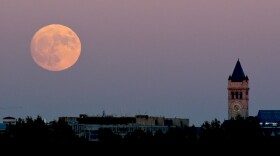-
On this edition of In Black America, producer/host John L. Hanson Jr. speaks with Dr. Bernard A. Harris, Jr., physician, former NASA astronaut, venture capitalist, founder and president of the Harris Foundation, and author of ‘ Embracing Infinite Possibilities: Letting Go of Fear to Find Your Highest Potential.’
-
The Cedar Park company's robot spent 14 days on the moon, the equivalent of one lunar day. Firefly says it's the longest commercial mission on the moon to date.
-
The spacecraft will spend the next couple weeks helping NASA run science experiments on the lunar surface.
-
The next supermoon — which appears larger and brighter than a regular full moon due to its proximity to Earth — will not be visible for nearly a year.
-
One year ago, on Christmas Day, the James Webb Space Telescope was launched. Since it began collecting data, it has captured - in stunning detail - previously unobservable stars, planets and galaxies.
-
NASA successfully crashed a spacecraft into an asteroid in a test of planetary defense. Now it will determine whether the mission was able to alter the asteroid's course.
-
The telescope uses a camera with filters that can make a color map out of infrared light, which is invisible to the human eye.
-
NASA's $10 billion new telescope showed the world something remarkable today: an image of some of the first galaxies to form in the universe.
-
June's full moon gets its nickname from the strawberry harvesting season in the Northeastern U.S. It also happens to be at its closest distance to Earth in its orbit, which makes it a supermoon.
-
NASA should send probes to the ice giant planet of Uranus and to a moon of Saturn where conditions could be right for life. Those are some of the recommendations in a new report to the space agency.
© 2025 KUT Public Media
A service of the Moody College of Communication at the University of Texas at Austin
webmaster@kutx.org
A service of the Moody College of Communication at the University of Texas at Austin
webmaster@kutx.org
Play Live Radio
Next Up:
0:00
0:00
Available On Air Stations










